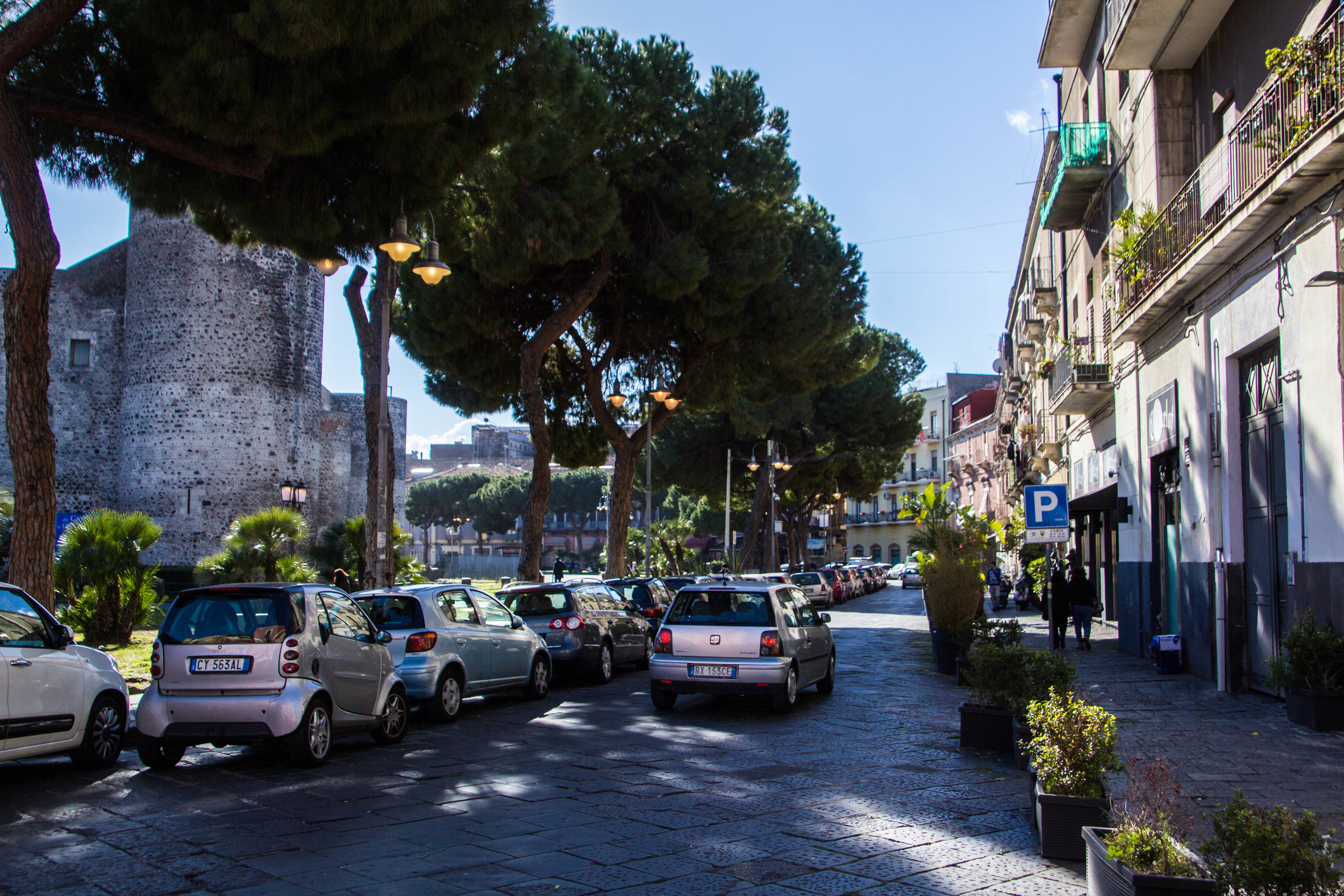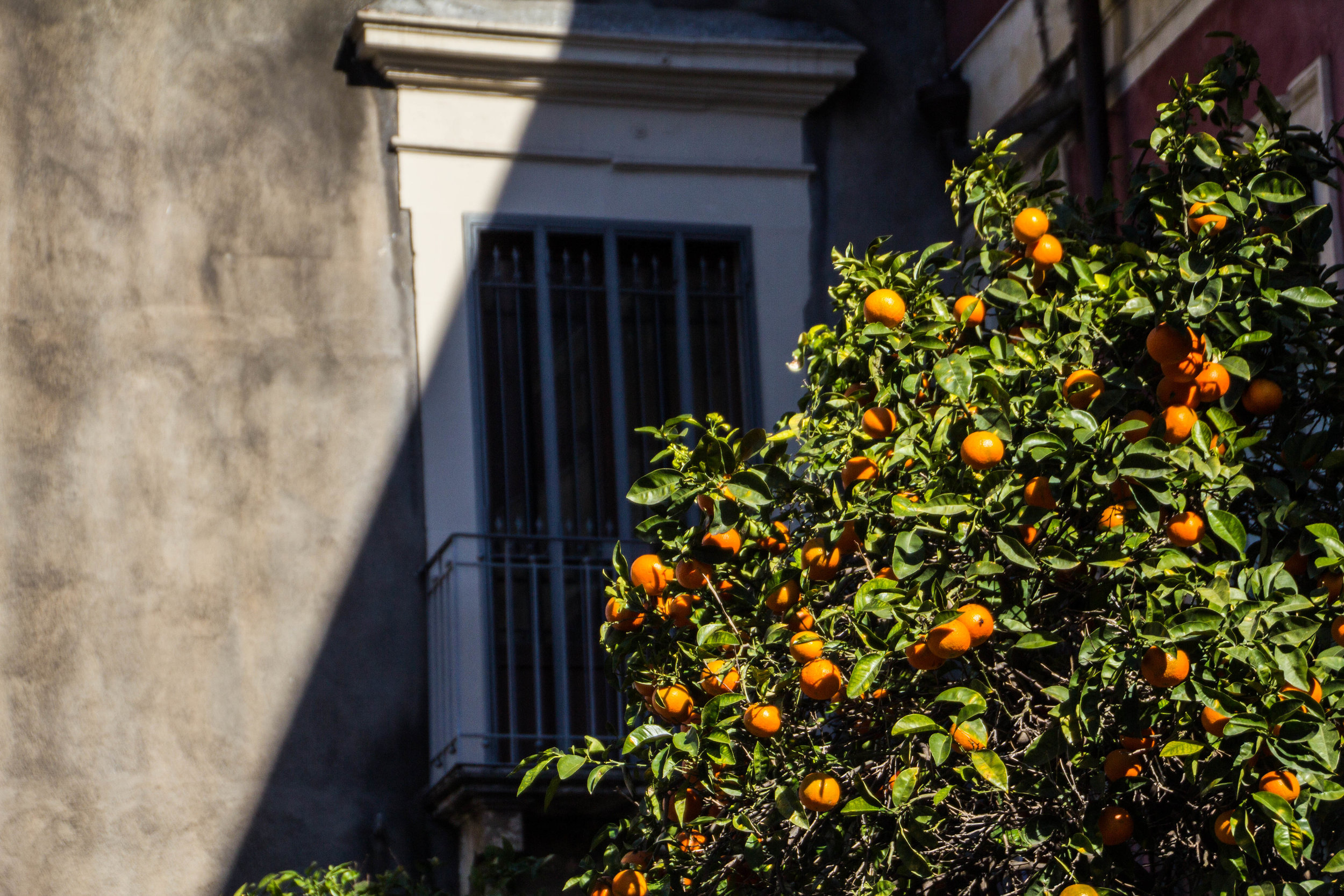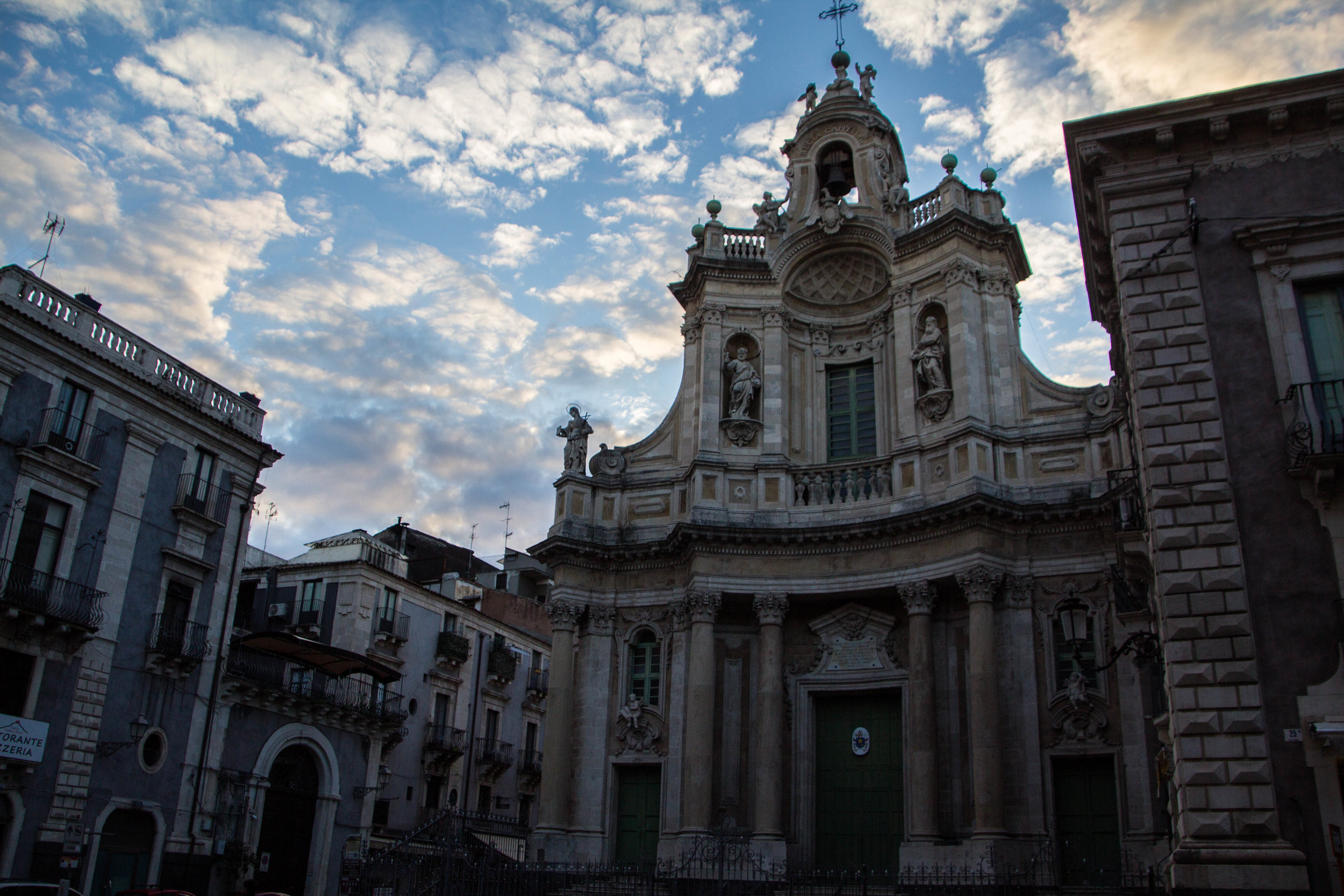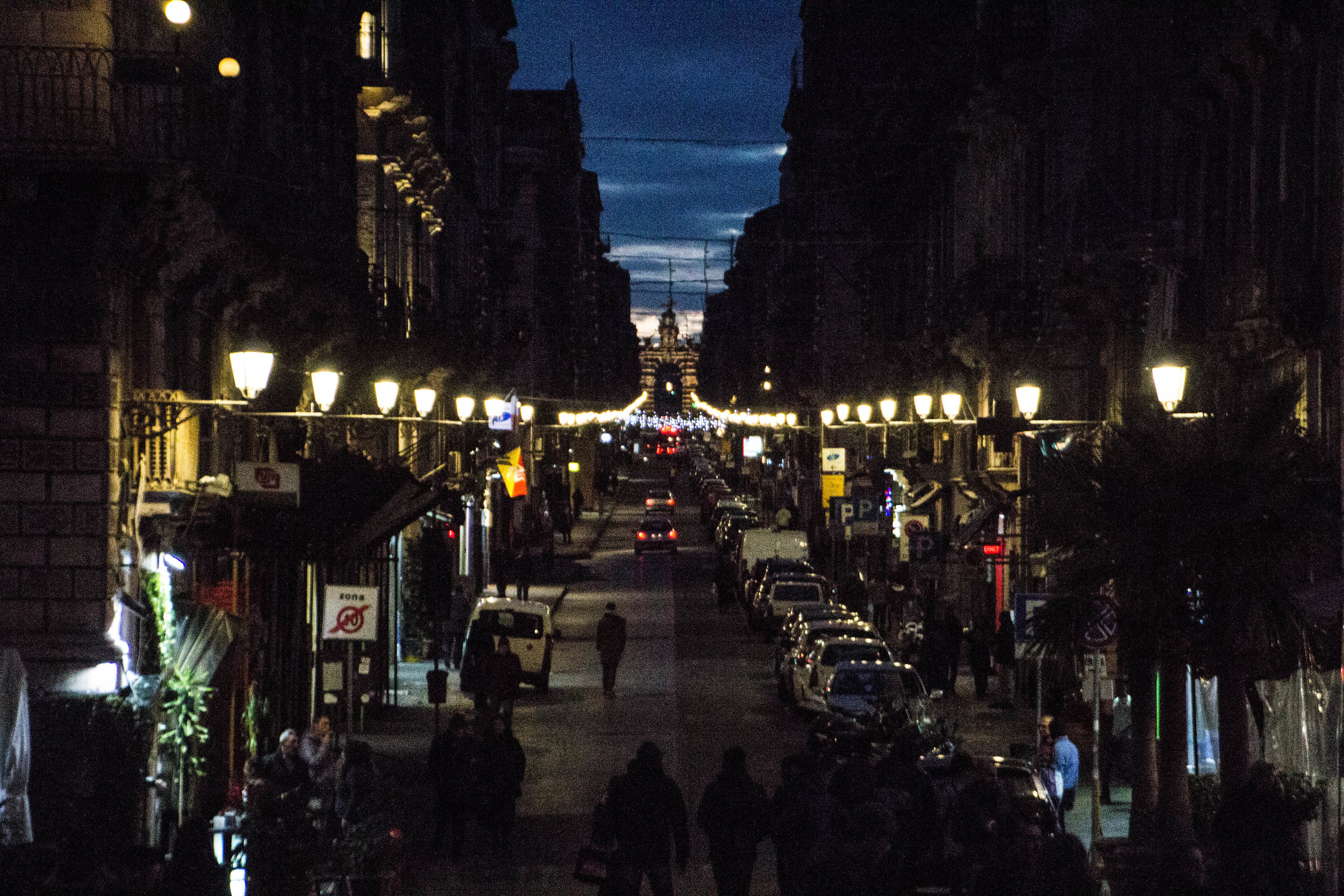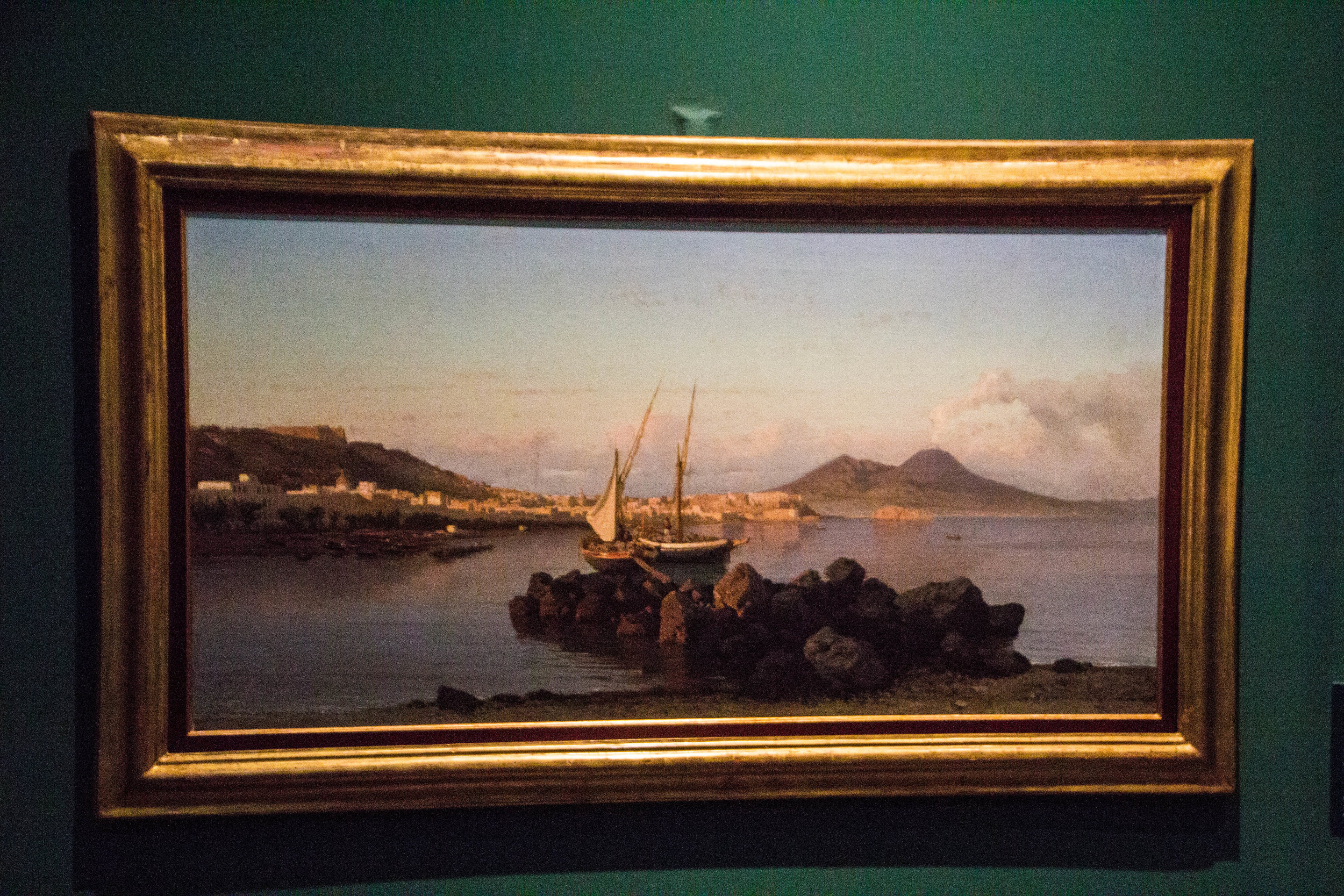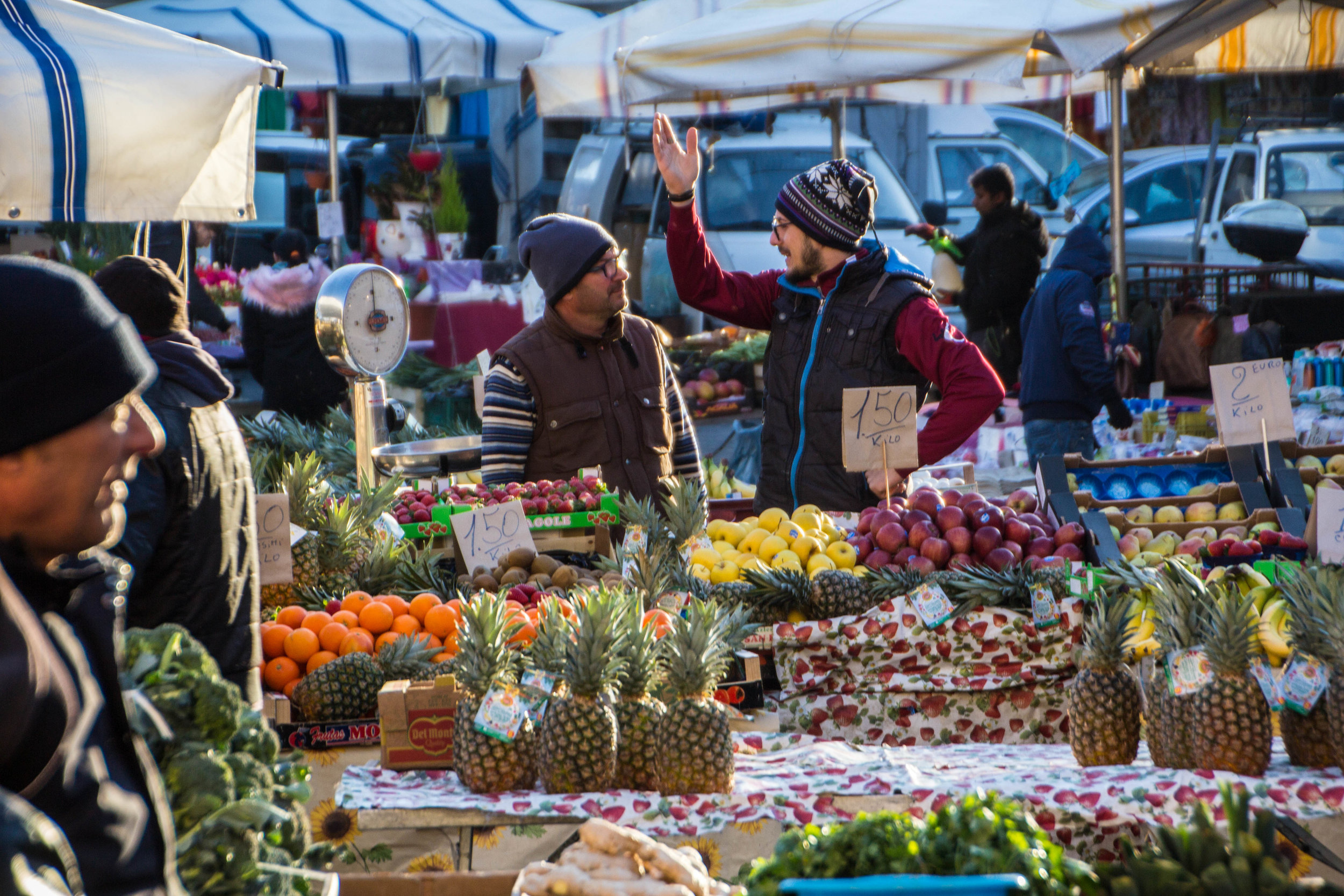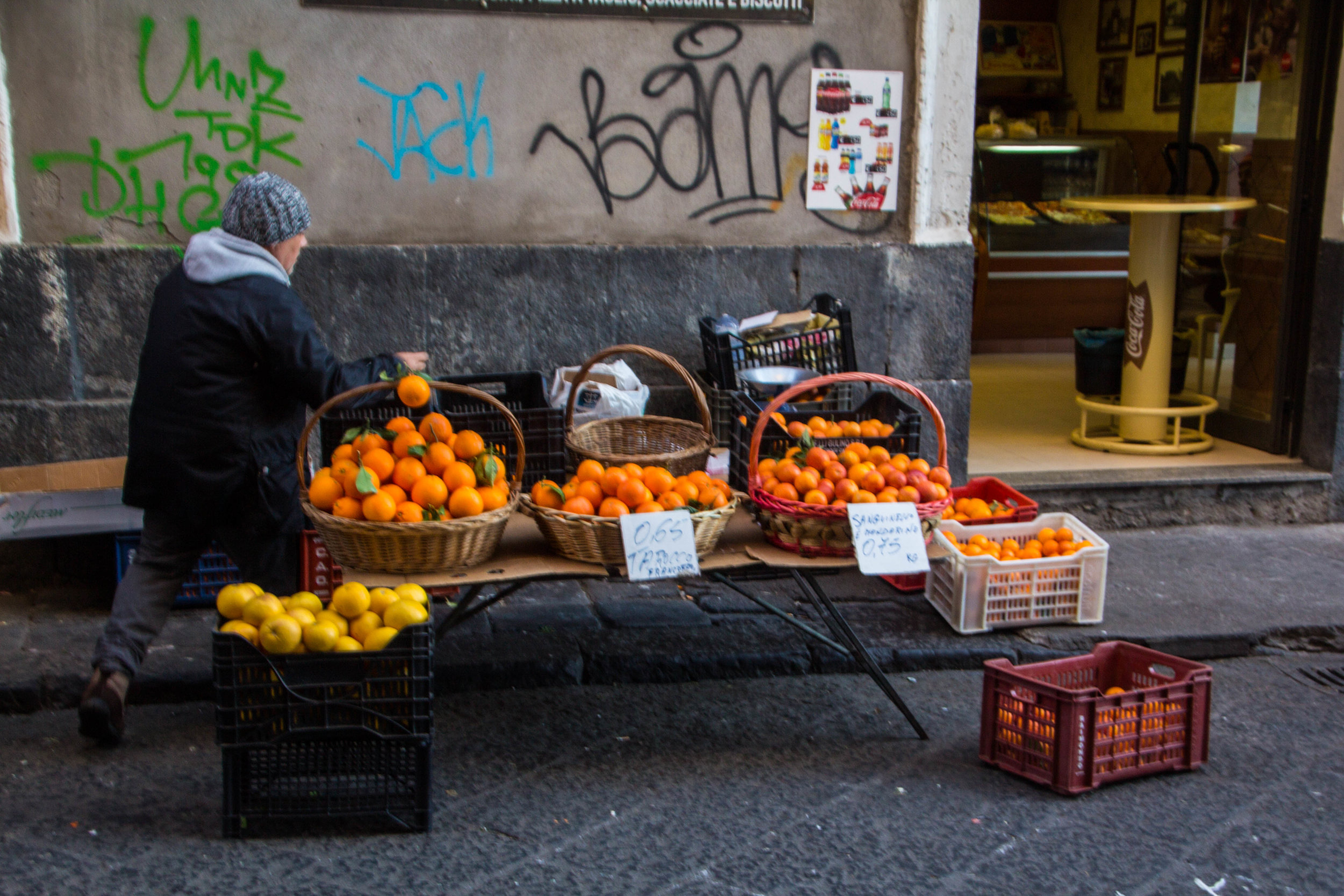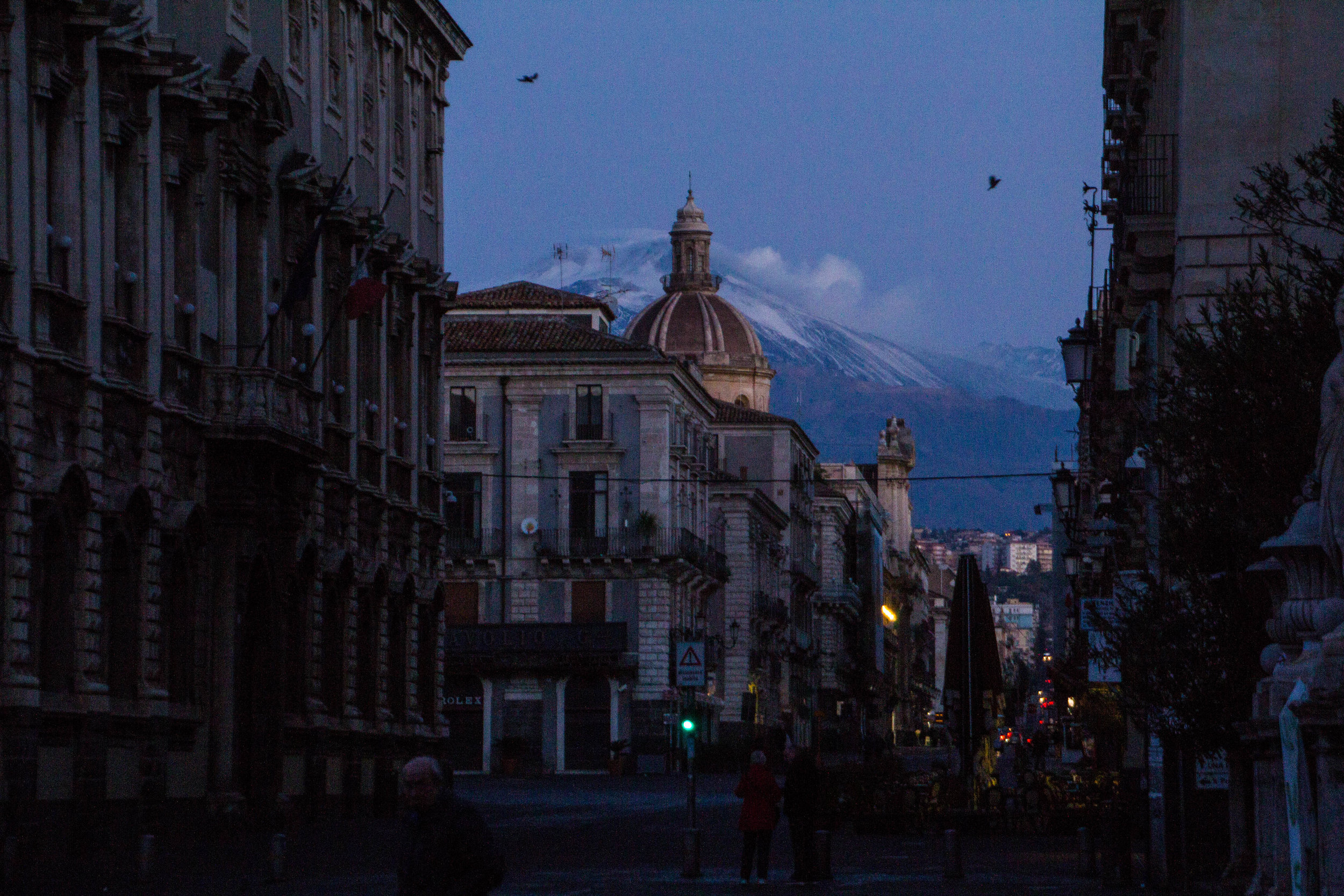Since this is my first time in Sicily, I should start by telling you that I am Sicilian by blood.
Or, more like half. My mother is fully Italian (and she happens to have been traveling with me for the duration of this series on Sicily). It has only been recently that I have come to realize what a big role Italian culture played in my upbringing. For example, like 80% of the food I was served as a child is straight out of classic Sicilian cookbooks. At any given time, our cupboards were at least 50% pasta and olive oil. On special occasions, my mom would make arancini. Our house was plastered with prints of Italian art that my parents brought back to the U.S. in the late 80s. And don't even get me started on our family reunions in New York. Italy was everywhere! But, of course, as a child you don't think about things in those terms. These were all just patches in the quilt that made up the fabric of my reality.
If you don't know what I look like, I'm a guy with some pretty distinct features. What I mean by that is I don't really look like anybody. Like, nobody has ever given me a celebrity doppelgänger—but landing in Sicily, I was immediately struck by the fact that everybody looked a LOT like me. Later in our trip, walking around Palermo, my mother would remark "Everybody here looks like my cousin!" And that's because these are our people. My heritage has always been a point of interest for me. I am proud to be Sicilian, and this familial connection is going to be something that I am processing on and off for the duration of this series. Consider yourself warned.
So are you ready to get started in Sicily? Let's do it.
An Introduction To Catania
Catania is the second largest city in Sicily. The population of Catania proper is about 320,000, but there are a combined 1.1 million people who live in the metro area. In Italy overall, Catania is the 10th biggest city, and the 7th largest metro area. This is a major population center for Sicily, second only to Palermo, which will be our last stop on this trip. Catania is not the most well-known place, but it's definitely not small either. It's actually really big, especially by Sicilian standards. But Catania's burgeoning population should be surprising. This isn't exactly prime real estate.
Why? Because of Mount Etna.
Towering over the city of Catania, Mount Etna is the most active volcano in Europe. Remember the snowy peak in the background of this article's header photo? That's Mount Etna. Pretty big, right? At 3,329 meters (10,922 feet) high, it's more than double the size of Mount Vesuvius.
Exactly how active is Mount Etna? Well...
Volcanic earthquakes and lava flows notoriously and completely destroyed the city of Catania in 1169 and 1693. Afterwards, the city was completely rebuilt in a new architectural style, which means that, for most of its history, Catania looked totally different from the city that exists today.
The largest 20th century eruption occurred in 1928, with lava flows destroying homes and covering heavily populated areas.
Other major 20th century eruptions happened in 1949, 1971, 1979, 1981, 1983 and 1991–1993.
Then a period of intense activity began in 1995, climaxing in 2001, with a moderate but very well publicized eruption physically threatening tourist and journalists.
Larger eruptions occurred in 2002/2003, throwing clouds of ash into the atmosphere that were so large they could be seen from outer space, raining debris across North Africa, even making it into shots of the Star Wars Episode III: Revenge of the Sith, which was being filmed in Tunisia at the time.
The next large eruption happened in 2006 and 2007, with a fireworks display of lava exploding out of Etna's caldera.
2008 saw a minor eruption with more than 200 earthquakes scattered around the area.
2011-2012 saw intense activity, with heavy volcanic ash forcing the closure of Catania's airport on several occasions.
In 2015, there was an eruption with a lava fountain that reached roughly 1 kilometer in height. 😬
The most recent major eruption was in March of 2017, wherein 10 people were injured (including members of a BBC film crew) when magma exploded on contact with snow. That's right—EXPLODED!
So that's what lives right next door to those 1.1 million people that live in and around Catania. All I can say is that this must be an interesting place to work in insurance.
But enough about that! There's a lot more to Catania than the volcano that could wipe it off the map at any moment. This city was founded in the 760 B.C.E. ballpark, and was a vibrant port city in both the Greek and Roman Empires before the Middle Ages rolled around. The island of Sicily would change hands a number of times over the next few thousand years, most notably to the Arabian and Spanish Empires, before eventually becoming part of unified Italy. This history is a lot less visually evident here than it is in other parts of Sicily because Catania was demolished by Etna in 1693; as a result, the architecture in this city is, for the most part, distinctly baroque in style. There's more history in Catania than can be covered in a single article, but you don't need to know everything about this place to enjoy it. Here's the city of Catania on the map for you to zoom in and play with...
Arriving in Sicily &
Exploring Catania
Before coming to Sicily, I had a lot of negative preconceptions about what it was going to be like here. When comparing Sicily to more northerly regions of Italy, people would often scoff. I heard over and over again how dirty and decrepit Sicily was going to be. Another point of discussion was how terrible the roads were, and how dangerous it was to drive. And I also heard people harp on the sketchiness of Sicily quite a bit, as if run-ins with organized crime were going to be a certainty of our visit. This didn't paint an awesome picture.
There is a long queue of articles from Sicily in the docket, but before we get to any of them, I'm going to give you a quick spoiler: none of that stuff turned out to be true. Or, at least not in the way you might be thinking.
However, my first impressions of Catania certainly reinforced the idea that Sicily is dirty. When we arrived at our Airbnb, there was trash all over the streets. Everything was grimy, graffiti was everywhere, and the buildings on our street seemed like they were just a small tremor away from completely collapsing. Our small apartment here would be "home base" for us for the duration of our time in Catania, so we spent a lot of time walking to and from this part of town. I think that, because of this, my earliest perceptions of Catania were that it was *exactly* as dirty as everybody said it would be. However, after a few days of walking around here, we had a sudden epiphany: we were staying in kind of a shitty neighborhood!
Yes, even Italian cities have not-so-nice areas. The heavy concentration of Chinese restaurants and migrant works should have been my first clue, but because people had set my expectations so low, it didn't occur to me that the whole city wouldn't look this same way. So let me set the record straight: Catania is REALLY pretty. (And if you're interested to look this up, we were staying at the intersection of Via Celeste and Via San Vincenzo dei Paoli.)
It took me a few days to wrap my head around Catania. By the time we were leaving, I still felt like I had only just started to get to know this place. Sicily has a lot of interesting layers to it, and unlike many other places in Italy and Europe, it made zero effort to present itself to me in a way that would be easy for me to digest. It was what it was and it is what it is. It doesn't need me to understand. I feel great when I can spend a few days in a place and then write about it as if I am the expert, but this was definitely not one of those places. I would need to spend some serious time living here to fully understand the identity of this place, and maybe one day I will, but for now I'm just going to share some first impressions and a sampler of attractions and photography.
Below are some of my favorite shots from around Catania. The aesthetic was certainly weathered, earthy, and borderline-dirty, but these elements were just so defining to the larger identity of the city that I don't think it's fair to isolate them and present them as if they are negative. They are what they are, and Sicily isn't soliciting opinions from you or me.
Catania's Greco-Roman Theater
So I'm going to cover a few notable tourist attractions in this article that should help get you into the swing of things with regard to Catania. The first one I'm going to touch on is the famous Greco Roman Theater. This an interesting site because it sits right in the middle of Catania, in quite a densely populated neighborhood. Despite it's historical status, the city has literally been built into and on top of this ruins site. This is not unique in Catania, but it's definitely my favorite urban ruins site out of what we saw. I took a quick screenshot from the satellite view of this place to show you just how nestled into the metropolis it is...
The Greco Roman Theatre is estimated to have been built around 300 B.C.E., and as the name suggests, was in use as part of both the Greek and Roman Empires. This ancient amphitheater seats around 7,000 people, and has survived countless eruptions and earthquakes over the centuries. However, due to the shifting ground beneath Catania, the center of the theatre is now flooded with water from the underground river that flows beneath the city. This river is called Amenano, and is actually responsible for a number of urban caves scattered across the city. Exploring all those little nooks and crannies around Catania would take years.
This place is accessible from Via Vittorio Emanuele II, and entrance costs 6.00 EUR (7.40 USD) for 1 person. It's open from 9:00am to 5:00pm (17:00) Monday through Saturday. On Sundays it closes early at 1:00pm (13:00). It's definitely worth a visit—it's extremely well-preserved, and you'll have free reign to explore any and every part of this ancient structure. It's obvious that some work has been done in various parts of this place to make it safer for visitors to poke around, but over all it still feels very much as it was. The sounds of traffic and people flowing down the surrounding streets are clearly audible from a seat in the weathered "bleachers" of this amphitheater, but despite the noise, the persevering stillness of this place provides a nice refuge from the hustle and bustle of Catania. If nothing else, it's a good break from walking.
Museo Civico Castello Ursino
Next up is Castello Ursino. In the central / southern reaches of Catania, the dense Sicilian cityscape opens up to reveal a wide plaza with a massive, gray castle sitting in the middle. It looks more clearly medieval than almost anything I've ever seen. I don't tend to associate that time period with Sicily, but make no mistake: Sicily during medieval times was nothing if not stereotypical. Picture big gray castles, and knights riding horses with shields, banners, and chainmail. This castle is just a small taste of that world.
Built between 1239 and 1250, Castello Ursino was originally one of the royal castles of Emperor Frederick II, King of Sicily. Its construction marked the end of a particularly turbulent period in Sicilian history, wherein a handful of local lords had attempted to win independence. After ordering the destruction of all non-royal castles, this mammoth castle was built as a sign of strength. In the following centuries, there are an endless string of stories involving battles, kings, lords, damsels in distress, kidnappings, etc. However, eventually the capital of Sicily moved away from Catania, and Castello Ursino was repurposed to serve as a prison. It was also one of the only structures in all of Catania to survive the earthquake of 1693.
So this place has some cool history, but I think that the most insane fact about this place is that when it was built, it was actually on a cliff overlooking the sea. But today it's not particularly close to the ocean. It's like a 15 minute walk to the water. Where did that extra kilometer of city blocks that stand in between this place and the Mediterranean sea come from? The answer is LAVA FLOWS!
Yeah! That really put the Catania / Mount Etna relationship into perspective for me.
Anyway, today this castle has been converted into an art museum. Its exhibits span Sicilian history from ancient times onwards. This includes artifacts from ancient Greece, as well as 20th century painters. It's definitely worth a stop! Entry costs 10.00 EUR (12.33 USD) and it's open Monday to Friday from 9:00am to 7:00pm (19.00) with the last tickets sold at 6:00pm (18.00). It's also open on both Saturdays and Sundays, closing an hour and a half later (which means the last tickets are sold at 7:30pm). Here are a few pictures from my visit to this place...
And here's the peak of Mount Etna off in the distance, looking out from the top floor of Castello Ursino. Can you imagine lava flows that large? Those eruptions must have been insane! Why is there still a city here?! Why did people keep coming back?? This is like the New Orleans of Italy.
🛑 Dinner Break! 🛑
Whew! All that walking around Catania was making me hungry, so let's stop for some food.
So, we ate a lot of food during my time in Sicily, but I don't think we found a single restaurant that we liked more than this one—and we found it completely by accident! We were wandering around Catania late one night, too tired to be overly invested in where we ended up, but too hungry to stop looking. After having walked 20 minutes further than we thought we would have to, and getting a little lost, we ended up here. And it was everything that I wanted my Sicilian dining experience to be and more.
We were immediately taken in and seated by an extremely cordial restaurant owner with gold chains, big glasses, and thick black hair, who randomly spoke excellent English. (This isn't exactly the norm in Sicily.) It was obvious that this place didn't get a lot of foreigners coming through, because it was filled with locals; families and friends speaking to one another in Sicilian. There was a buffet of classic Sicilian antipasti dishes. For our appetizers, we had free reign to sample any and all of these dishes. This included olives, cheeses, roasted peppers, egg frittata with spinach, salami, and more. For the main course, we ordered pasta with cream and pistachio sauce and beef involtini, breaded, and stuffed with cheese and tomato sauce, respectively. With dinner we drank traditional Nero d'Avola (wine) and for dessert we were served some sort of incredible chocolate mousse dish. (sigh) What a meal!
This place is called Trattoria da Rinaldo de Giuseppe Ardita, and it's located at 59 Via Giuseppe Simili. You can see it on Google Maps here. This is the only restaurant I'm going to recommend throughout ALL of my articles from Sicily. Be advised that they are closed on Mondays. Here are a few photos...
Back To Business...
Catania's Main Market
Next we're going to check out Catania's famous street market, not to be confused with Catania's fish market, which I will get to shortly. Catania's main street market sells everything from clothes to kitchenware, but to me, the most scenic sections of any market is food. So the majority of the photos you wills see below are in the 'food' section of the market, which is quite substantial.
So before I go any further, I want to answer one key question: where is Catania's main street market? The map below will show exactly where. If you are in need of a landmark, just go to the Sanctuary of the Madonna del Carmine (a.k.a. Santuario della Madonna del Carmine). That is the name of the big basilica that sits in the main square. The square is called Piazza Carlo Alberto.
These types of concentrated open-air street markets supposedly came to Sicily in the 9th century with Saracen rule over the island and are historically linked to Arab influence in the region. This was surprising for me to learn because, today, these markets feel as Sicilian as Sicilian can be. I never got tired of walking through these communal spaces, absorbing the smells, the language, and the culture swirling all around me. I made multiple visits to this market during my time in Catania—here are some of my favorite shots...
Via Etnea + Piazza Duomo
Via Etnea and Piazza Duomo are both major centerpieces of Catania. If Piazza Duomo is the heart of Catania, then Via Etnea is the jugular artery. Or, at least from a cultural standpoint. If you just want to take a quick walk through historic Catania, this route should be 'plan A.' Via Etnea is longer than what is shown in the map below, but I think the best walk you can take down this street starts with Giardino Bellini Park and stretches southward to Piazza Duomo. Here's everything on the map for some context:
The first time we walked down Via Etnea was early evening on a Sunday. I couldn't believe how many people were walking all at the same time. However, my mother—who was raised in a very Sicilian household—was much less surprised. She explained that this is called "Passegiata," which is an Italian word referring to the pre-dinner stroll that everybody takes around the same time. This is a custom that actually extends beyond Sicily, through other parts of Italy. Passegiata is a social event for Sicilians, and many of them will actually dress up for it. How and when exactly this unfolds will vary slightly from place to place around the region, but the key is that everybody walks together slowly through the center of the city, or by the sea. Typically this happens somewhere between lunch and dinner on Sundays.
Let me just say that this is an awesome tradition! I love cultures that are so social! It's no wonder Italy is home to one of the world's 5 "blue zones." I'd love to do this every Sunday with my community. It was such a friendly atmosphere... and weirdly familiar. The first 5 pictures in the gallery below are from that walk.
Now let's shift over to Piazza Duomo. This place is known first and foremost for the elephant statue that sits at the top of its central fountain. This is church that is this square's namesake is definitely one of Catania's less recognizable landmarks. There are some pictures from this plaza in the gallery above, but there was one group of photos that I took here that stand out above the rest.
Because of this square's proximity to the fish market, I spent a lot of time here. I'll get to the fish market next, but before I do, I will tell you that my visits to this place put me in Piazza Duomo for sunrise on a couple different mornings. And during those mornings, I got some beautiful shots looking north, up via Etnea. Yes, that snowcap is Mount Etna in the background.
Catania's Fish Market
Sneak Preview 👀
One of the most defining landmarks in Catania is the fish market. I got up before sunrise to catch this market in action twice during my stay in Catania, and the photos I got during these visits were among my favorites from all of Sicily, so we're going to break this piece off into its own, separate article. Here's a couple sample photos as a preview...
So are you ready to wake up at 4:30am with me?!?
We're going to make the trek across Catania in the middle of the night to see the fish market slowly come to life as the sun rises. I promise we'll stop for an espresso on the way, so stop complaining and set your alarm! It's going to be worth it.
See you tomorrow morning, bright and early!



